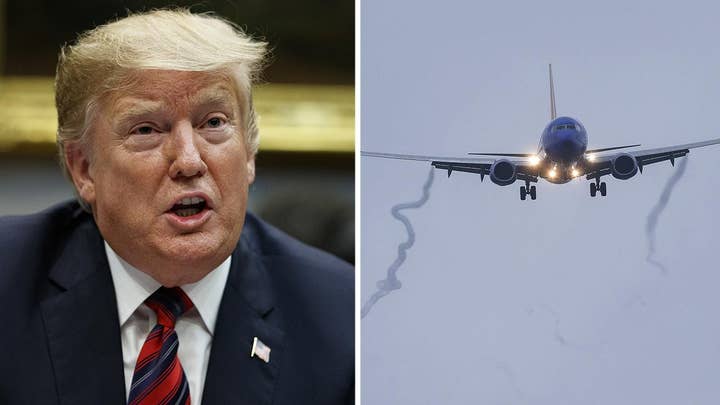Boeing under pressure as its 737 Max aircraft sit idle
Doug McKelway reports on the economic impact to the world's largest aerospace company from the grounding of its best-selling plane after two fatal crashes.
Collective sighs of relief – and groans – were heard around the world Wednesday as the U.S. Federal Aviation Administration bowed to pressure and joined nations around the world to temporarily ground the U.S. fleets of Boeing 737 Max 8 and Max 9 jets following two deadly crashes abroad.
One benefit of the FAA grounding the planes is that the squabbling about what to do about the jets is over – at least for now.
We’ve heard from some that grounding the planes was an overreaction amounting to a witch hunt. Others have said grounding the jets was a moral imperative to prevent further loss of life in more crashes.
BOEING'S 737 MAX 8S ARE UNDER SUSPICION, BUT IS THE PILOT OR PLANE TO BLAME?
At least now, all parties are one big step closer to being on the same page in investigating why an Ethiopian Airlines Boeing jet crashed Sunday – killing all 157 people aboard – and why a similar plane flown by Lion Air of Indonesia fell out of the sky five months earlier into the ocean and claimed 189 lives.
America’s FAA, National Transportation Safety Board and Boeing can now devote time and resources to assist the Lion Air and Ethiopian Airlines crash investigations. At the same time, Boeing can look for engineering and software solutions to the problems that may have caused the crashes of the jets.
As the rest of the airline industry gets back to normal, we have a break from the chaos.
The FAA said it made its decision to ground the two models of Boeing jets due in part to evidence collected at the site and analyzed Wednesday.
It’s believed that evidence includes satellite data indicating an erratic vertical (altitude) profile of the Ethiopian Airlines flight for the six minutes it was airborne between takeoff and crash. This was an unstable series of climbs and dives that eerily resembled the 12-minute flight of the Lion Air plane involved in the other tragedy.
This data is a bonus to the investigation and helps to validate correlative information released Sunday within hours of the Ethiopia accident by Flight Aware, a popular tracking website providing detailed information about thousands of flights daily.
We know that two Lion Air flights suffered similar erratic losses of pitch control, resulting in a rollercoaster ride but otherwise safe landing for one crew, and the next day, in the same jet, a steep dive that a 6,000-hour captain and 5,000-hour copilot were unable to defeat.
These are important pieces of an enormous investigative puzzle that – fragment by fragment – forms a murky image that eventually becomes clear to see. A re-creation of the accidents is needed to prevent them from ever happening again.
Now we wait for investigators to release clues from the cockpit voice recorder and flight data recorder of the plane that crashed Sunday. From those clues, investigators may learn what went wrong, and from their findings, we’ll work to improve aviation safety in a myriad of ways – through more reliable engineering, better procedures, improved training, enhanced crew coordination and other steps.
Some positives will no doubt arise from both crashes. It’s the ironic legacy of most fatal airline accidents that in the end the industry rebounds stronger and safer.
The lives of the people so tragically killed in the airline crashes – and the incalculable pain and loss suffered by their families – will not have been in vain. We can be certain that through investigation and response, there will be changes to air travel. We can be reasonably sure there will be improvements.
The last decade has seen unprecedented safety improvements for the airlines. From intense scrutiny upon the 737 Max 8 accidents, pilots around the globe – whether temporarily grounded or actively flying – are primed on high alert.
CLICK HERE TO GET THE FOX NEWS APP
They are ready to act in the event of a malfunction that was always insidiously dangerous, but seldom transpired – runaway stabilizer trim.
Bruised by these catastrophes to their ranks, pilots remain our last line of defense on the front lines of safety. The investigations can be disturbing. Judgments will be made. Families will pray to see loved ones exonerated. Pilots’ last words will be heard. And in the end, valuable lessons will be learned, nudging aviation to become ever safer.


